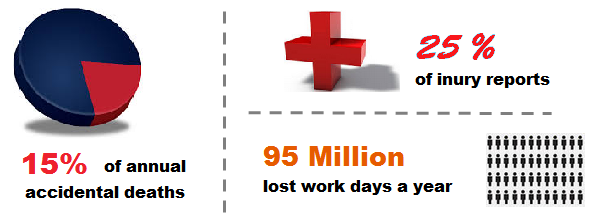RL Blogs

By Steve Pagani
Oct 04, 2015The activities that we take for granted often cause the most safety incidents. |
||||||||
| While refineries are dangerous places with many catastrophic physical and chemical hazards, many lose sight of the simple activities that create the highest amount of incidents. It is not uncommon for refineries to list “Slips, Trips and Falls” as a high frequency incident categories, with outcomes that can lead to days away from work.
In fact, check out some of the industry statistics on STF’s.
Statistics courtesy of EHS Safety News America
How can refineries boast such excessive amounts of safety slogans and jargon throughout the yard, but yet have such a difficult time asking employees to walk safely? What gives?
Do any of these events sound familiar:
STFs can happen to anyone and do not discriminate between indoor vs outdoor activity, field worker vs office worker, or even hourly vs salaried employee. The fact of the matter is that it WILL happen to someone in the refinery.
The question is how can we reduce, and ultimately prevent Slip, Trip and Fall incidents? Incident prevention first comes with risk recognition. All employers and employees need to recognize incident priming conditions, such as:
Once the risks are defined, the refinery folks need to work together to mitigate or raise awareness to the risks.
You can over-engineer any solution or you can under-mitigate any issue. The key is to balance solution effectiveness and sustainability with effort and spend. This sounds like senseless management rhetoric, but organizations that achieve this proper balance understand how to make the right trade-offs.
Examples of effective solutions include the following:
Create Good Housekeeping Practices
Reduce Slippery Surfaces
Maintain Proper Lighting
Wear Proper Shoes
The last barrier of defense is human behavior. As academic understanding evolves in this space, human factors supporters continue to point us down the path of enhanced engineering solutions. While there is certainly a place engineered solutions, you ultimately cannot replace plain common sense.
While common sense is often subdued by the enticing charms of Mr. Distraction and Ms. Shortcut, it regularly needs to be reinforced by work peers and leadership.
Reinforcement does not simply come in the form of a cheesy safety slogan, but an authentic reminder that every task should come with ample preparation. Whether it is hot-tapping a hydrocarbon line, or simply walking to the control room, “Do it safely or don’t do it at all”. | ||||||||
|
|









